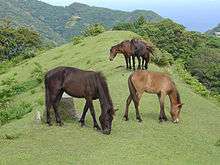Misaki horse
 | |
| Alternative names | Misaki uma |
|---|---|
| Country of origin | Japan |
| Equus ferus caballus | |
The Misaki (御崎馬/岬馬 Misaki uma) is a breed of pony that is native to Japan. Like other native horses of Japan, it is believed to have developed from horses brought to Japan from China, with the earliest imports dating back at least 2,000 years. The Misaki is one of eight breeds considered native to Japan, [N 1] and lives as a feral horse in a natural setting in a designated National Monument on Cape Toi (also known as Toimisaki) that is located within the municipal boundaries of Kushima at the south end of Miyazaki Prefecture on the island of Kyūshū.
The breed was first identified in the historical record in 1697 when the Akizuki family of the Takanabe Clan rounded up feral horses and developed a pool of breeding stock. Today, the Misaki is classified as an endangered but "maintained" breed, with only about 100 living animals. This population has remained relatively stable for the past 20 years, up from a low of 53 individuals recorded in 1973.
The Misaki ponies are a popular draw for tourists in the region and were designated a National Natural Treasure following the end of World War II.
Characteristics
The Misaki is of pony height, and stands between 12.2 and 13.2 hands high at the withers. However it has horse characteristics and proportions. Most individuals are colored bay or black, with the occasional chestnut. White markings are rare.
See also
Notes
- ↑ The eight native Japanese horse breeds are the Hokkaido Pony, Kiso, Misaki, Miyako Pony, Noma pony, Tokara pony, Tsushima, and Yonaguni
References
- "Country Report (For FAO State of the World’s Animal Genetic Resources Process)", Editorial Committee Office of the Japanese Country Report, Animal Genetic Resources Laboratory, National Institute of Agrobiological Sciences, Japan.
- Misaki breed page from Oklahoma State University
- "Misaki"
- Hendricks, Bonnie L., International Encyclopedia of Horse Breeds, Univ of Oklahoma Press, 1995.
External links
| |||||||||||||||||||||||||||||||||||
The breed along with the other eight Japanese native breeds in October 2007 issue of Horse Illustrated magazine by Bow tie press.
.jpg)